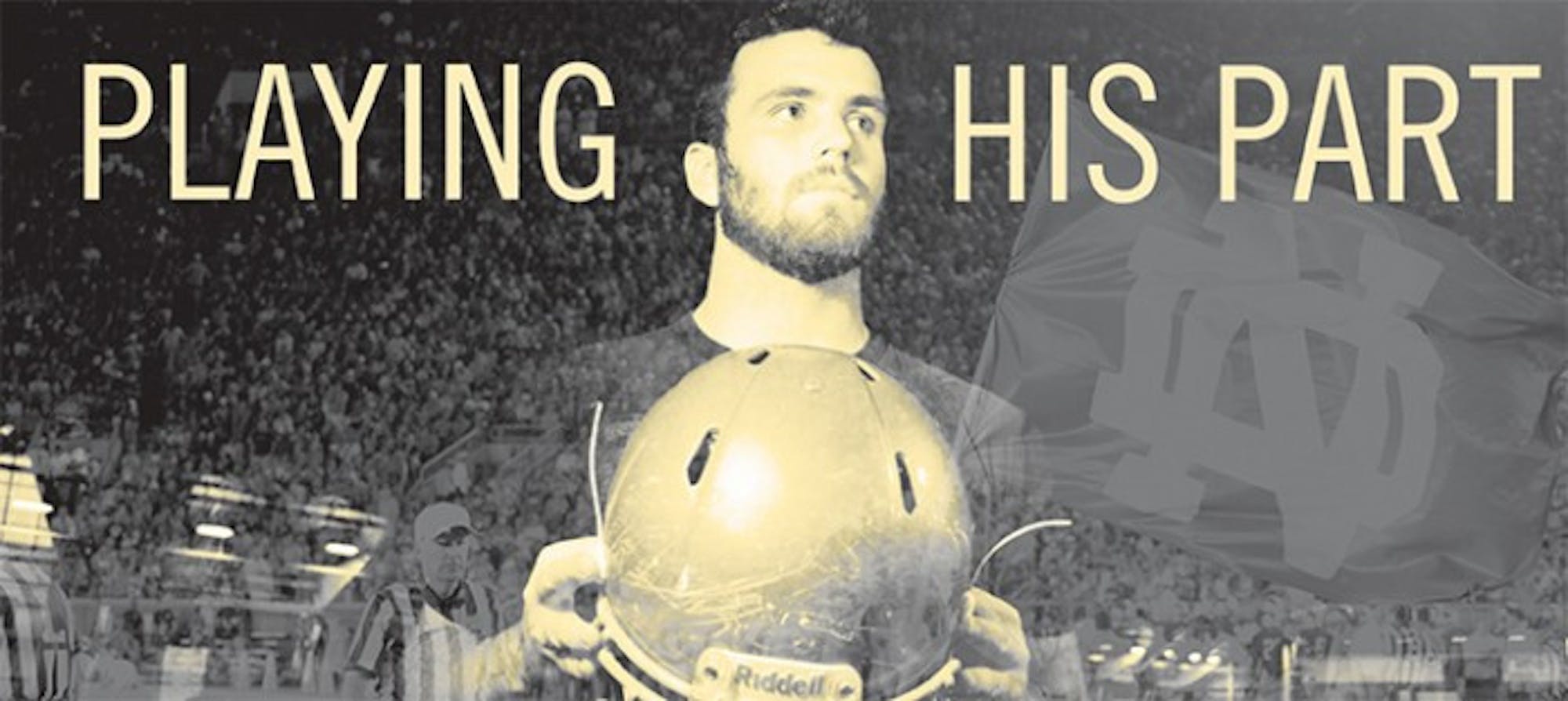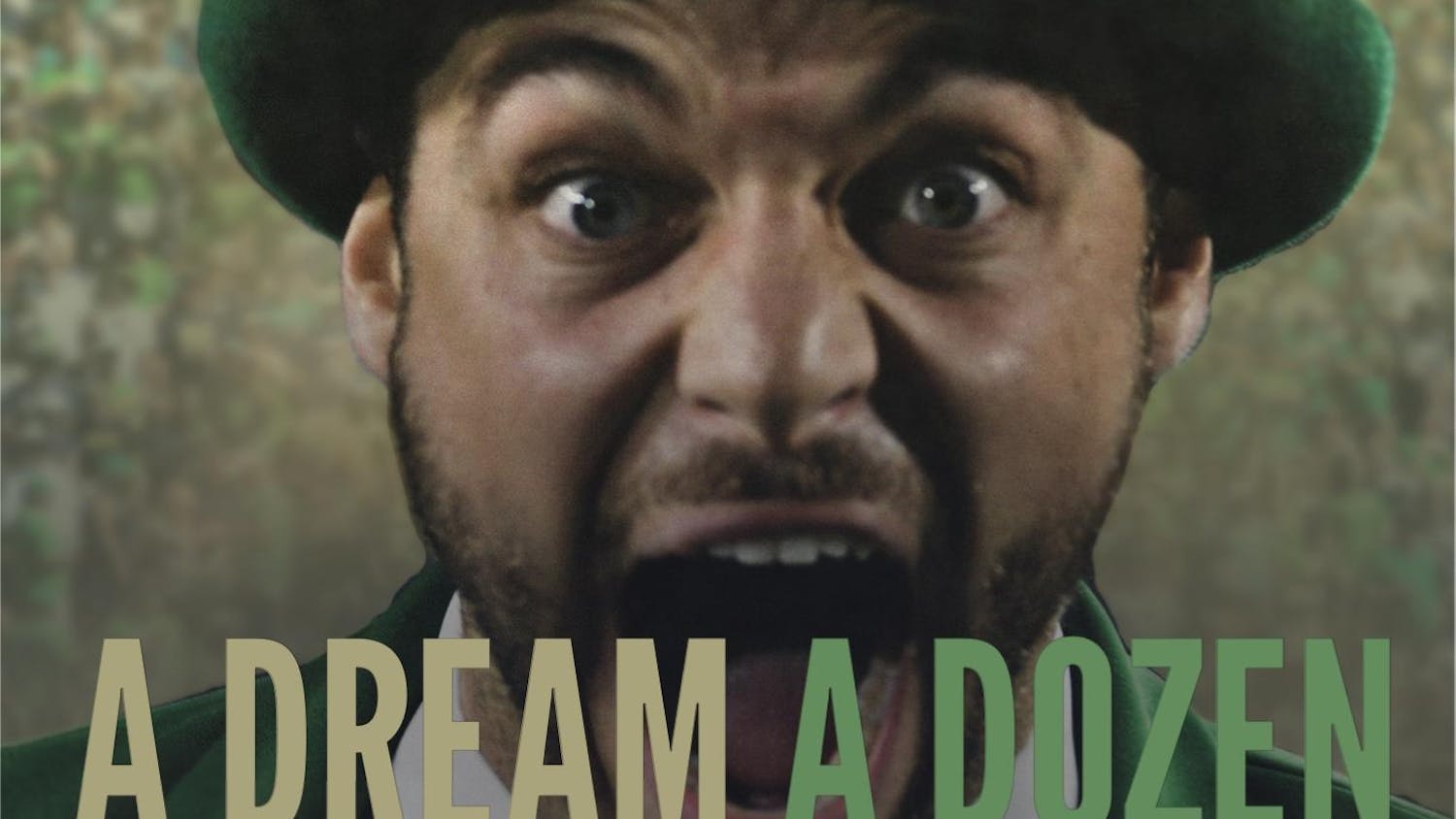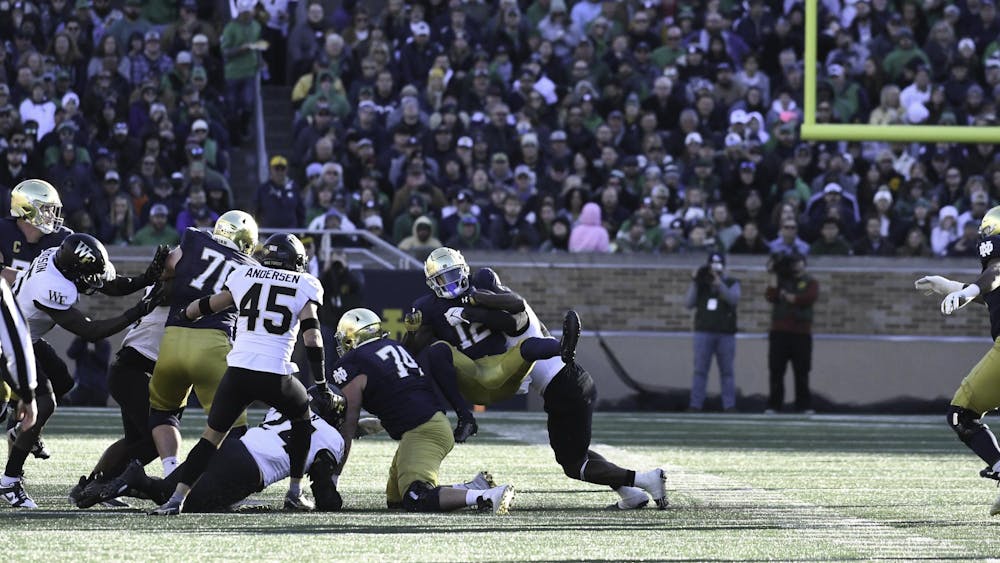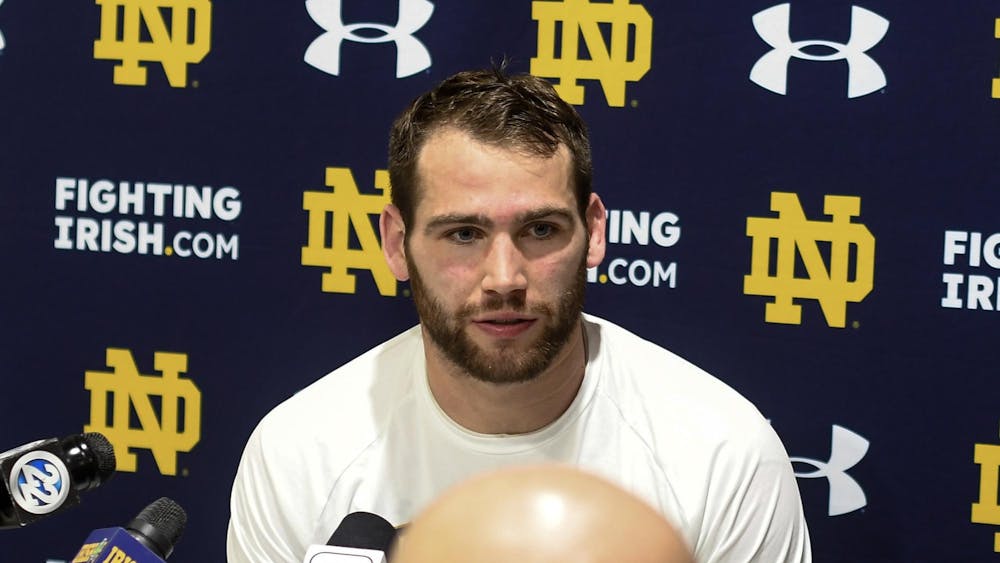
Editor’s Note: A version of this article originally appeared in the Sept. 23 edition of The Observer.
Every Notre Dame fan remembers the winning touchdown against Virginia last season.
Trailing by one at the Cavalier's 39-yard line facing second-and-9 with just 19 seconds remaining, backup quarterback DeShone Kizer rolled to his left and found a streaking Will Fuller edging behind the Virginia secondary for a touchdown that saved the Irish from what would have been a disastrous early-season loss.
Amid all the headlines from that Irish victory over the Cavaliers last season — such as Kizer’s sudden promotion from unknown to hero after Malik Zaire broke his ankle late in the third quarter — one wouldn’t blame Irish fans for missing one piece of news: then-junior tight end Durham Smythe had torn his MCL and would miss the rest of the regular season.
Nor will many fans remember that Smythe made an important “play” on that torn MCL right before Kizer found Fuller for the final score.
Smythe’s play was not a highlight-reel catch, however. It was not a pivotal block.
It did not leave a lasting image like Kizer streaking down the field with his arms raised in celebration or break the internet like the heartbroken Virginia student draped over the wall.
It was, however, an effort that demonstrates the grit and unquantifiable nature that makes tight end one of the most underappreciated positions in college football.
With 43 seconds remaining in the game, Kizer threw to his right on a screen to running back C.J. Prosise, who was tackled in-bounds after picking up just a yard. Smythe had lined up on the opposite side of the formation and kicked out farther to the left to block a Cavalier defender.
“Forty seconds left, we’re running that screen to the right. I go out and meet my guy in the hole, the alley player, the SAM,” Smythe said. “I’m trying to stay in front of him and all of a sudden, I just feel someone full speed roll into the side of my leg.
“And to be honest, I thought when it first happened, ‘My leg is broken.’ It rolled on me — I snapped back, kind of, I felt a couple pops. I thought, ‘Oh, this is going to be really bad.’ Rolled over, saw that my leg was intact at least, facing the right direction.”
Notre Dame had only one timeout remaining, and in college football, if an offensive player is injured and needs to receive medical attention with under two minutes remaining, his team has to use a timeout or let 10 seconds run off the game clock.
The Irish could ill afford either option. And Smythe knew it.
“It was kind of all in the heat of the moment, but then I realized there’s 30 seconds left in the game … I don’t want to lay here and get a 10-second runoff and lose the game because I am laying on the field,” Smythe said. “So I roll over, kind of power limp off the field, jump onto the table, tell the trainers that my leg is in some trouble and then all of a sudden the crowd goes crazy.”
The very next play, Kizer found Fuller at the pylon.
“Luckily Will Fuller came through for us there,” Smythe said. “At least we got the win, but personally definitely not one of my brighter moments. ...
“From a strictly pain side … there’s adrenaline running — we’re at the end of the game trying to make a crazy comeback so I’m focused on that, but that was an extremely painful couple seconds for me, and then the plane ride home.”
Being able to bear his fair share of pain shouldn’t come as a surprise, though. For Smythe, making the unquantifiable plays is just what comes with the territory at “Tight End U.”
“It’s the resume that’s presented to you,” Smythe said. “With the track record that we’ve had here … with me, growing up I watched [Kyle] Rudolph, [Tyler] Eifert, [Anthony] Fasano. It goes back really far. ...
“[Playing tight end at Notre Dame] becomes a responsibility. I tell a lot of people it’s kind of a mix between a responsibility and an honor because, first and foremost, you’re getting your name mentioned with all these guys who have done incredible things. But then it becomes a responsibility to keep the name ‘Tight End U’ and uphold the production.”
For Smythe, that production is hard to find on a stat sheet: in his career, he’s totaled just 13 receptions for 137 yards. Five of his 13 grabs have been for touchdowns, though, including two — both of his receptions — against Army last weekend, one in the loss to Michigan State and one on a fake field goal earlier in that game against Virginia in 2015.
While he came out of high school more involved in the pass game, Smythe said he’s worked hard on both facets of being tight end in college football — catching the ball and blocking for the person with it.
“It’s about flipping the switch, especially at our position, because, day-by-day, we’ll be working with the offensive line for a portion of time with an emphasis in the run game or with the receivers with an emphasis in the pass game,” Smythe said. “ … Over the years I’ve come to really appreciate the run game … and honestly, if I had to say at this point, they’re probably pretty even for me.”
Smythe showed that ability against the Spartans a few weeks ago.
During Notre Dame’s second drive, Kizer rolled left and stared down Spartan sophomore cornerback Vayante Copeland. Copeland had to make a choice — stop Kizer’s running lane and leave sophomore receiver Equanimeous St. Brown open behind him, or stick with St. Brown and let Kizer take off. Copeland chose the former, and Kizer lofted the ball over him to St. Brown, who raced down the sideline for 48 yards to the Michigan State 28-yard line.
Copeland had to make that impossible choice because Smythe was ahead of his quarterback, locked up with the Spartan defender who was supposed to prevent Kizer from reaching the edge.
Then in the fourth quarter, Smythe ran a post to the middle of the end zone, initiating contact with and shaking loose from the physical Spartan defender shadowing him. Kizer hit Smythe on the numbers to bring the Irish within eight points.
Smythe said he paid a physical price for his other touchdown too, back against Virginia. Notre Dame faked a field goal and Kizer — still the unknown backup quarterback and holder at that point — flipped the ball to Smythe on a shovel pass. The tight end barreled his way into the end zone, landing hard on his shoulder.
“I had a shoulder sprain the week before [in the victory over Texas], so I took some medication before to kind of numb it up a little bit,” Smythe said. “Fell on that during the game and really dislodged the AC joint in my shoulder, so I was playing all game with a dead right arm.”
Smythe had surgery on both his knee and shoulder the following week, and he spent the rest of the regular season on Notre Dame’s injury report, included with the likes of quarterback Malik Zaire, running back Tarean Folston and defensive backs Drue Tranquill and Shaun Crawford.
“I would never call it a blessing because everyone in there is out for an extended period of time, but I think it really help as individuals,” Smythe said of rehabbing with so many others. “Maybe we wouldn’t want five other guys in there like there was, but … we developed a relationship, all of us in there, just kind of pushing each other. We’d come in on days where we’re feeling extra sore and you look over and Shaun Crawford is stretching his leg and he’s over there biting on a towel. … So it kind of became one of those relationships like if this guy can do it, I’m obviously going to do it too, which maybe not a blessing, but as individuals, it all helped us recover faster.”
Smythe returned in time to start for the Irish in the Fiesta Bowl, making one reception for five yards. He started all three games he appeared in last season, catching one pass in each game.
Now a senior, Smythe said his journey to “Tight End U” wasn’t all that surprising, in hindsight.
“I grew up a huge Notre Dame fan, randomly,” Smythe said. “My dad and mom always preached to me from a really young age that you need to find the best mixture for you, but also the best mixture of academics and athletics.
“So I don’t know when this was, maybe sixth grade or before, but obviously I knew the top football programs so I googled the [US News and World Report college rankings]. Just went through looking for schools at the top of the list who also had great football programs and I came across Notre Dame at 13 or 14, and I checked them out more. And then I kind of just developed a crazy interest from there.”
Originally Smythe committed to Texas after then-head coach Mack Brown came to his school. Growing up a Baylor fan — his father was an offensive lineman for the Bears and lettered on the school’s 1980 Southwestern Conference championship team — Smythe said he’d always hated the Longhorns but admitted the state’s flagship school dominated in the area.
“Back then, my junior or sophomore year, Texas was — if you got a Texas offer, especially in my area, Texas was an hour away, you’re going to Texas basically,” Smythe said. “So I kind of jumped on that pretty quickly, was committed for a few months, but kind of realized toward the end of my recruiting process that Notre Dame was still there.
“Notre Dame is something that I’ve wanted to do since I was 10 years old. So I took a visit up here in January. There was three feet of snow on the ground, and I’d never seen snow like that at all before, but I fell in love. I fell in love with the people, the campus. It was everything I’d imagined in my head but even more.
“And I kind of just knew stepping foot on campus that this was the place for me.”













